
Sherborne Abbey, Dorset
We hadn’t planned to visit Sherborne during our time in Dorset back in the summer, but went there on impulse when we found ourselves in the vicinity. So annoyingly I hadn’t researched it in advance and didn’t read the guide book until weeks later. So I find I missed quite a few features I will have to seek out next time.
The first thing I noticed was that it is made of the same golden Hamstone as Minterne House, the place that brought us to the area and which I blogged about here.
The people of Sherborne seemed very friendly and as I was buying a guide book a man was looking heavenward and said, portentously: “The swifts have gone”. It sounded like the ravens leaving the Tower of London, but he explained that the migratory swifts of the abbey always head south to Africa around this time of year, within a day or two. This was August 16 and we had just missed them.

Waterspout on the south front of Sherborne Abbey
Sherborne is in the north of Dorset and Yeovil is not far away, just over the border in Somerset. There has been a place of worship in Sherborne since AD 705 but the current building dates from the Middle Ages. It has sometimes been called the cathedral of Dorset.
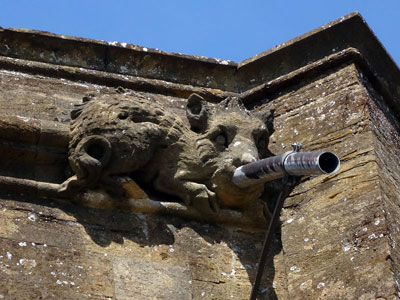
Another characterful waterspout
St Aldhelm is believed to have founded the church in 705, but there may have already been a Celtic church here, beyond the west end of the current abbey.
Aldhelm was a prince of Wessex, born around 640 and an early convert to Christianity. He was educated at Canterbury and Malmesbury and may even have studied in Iona and Ireland.

St Aldhelm looks down from above the south west porch
Around 680 Aldhelm became abbot of Malmesbury, well to the north in Wiltshire, then in 705 Ine, the Christian king of Wessex, sent him to a new diocese of Sherborne covering Dorset, Somerset and Wiltshire, to battle paganism. He was there only four of five years and later buried back in Malmesbury. Little is known about what he did at Sherborne.
Until 998 there were just a few monks here with a bishop, who was also the abbot of Malmesbury, but in 998 the 20th bishop, Wulfsige III (also known as St Wulfsin) created a fully fledged monastery.
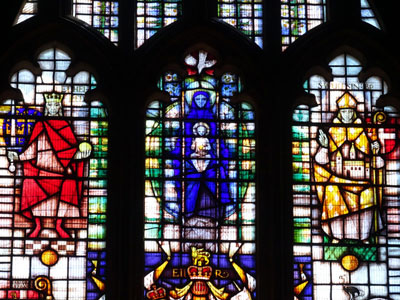
That’s St Wulfsige in yellow on the right of the Virgin Mary – on the left is King Ethelred – this is part of a small window installed in 2001
Today’s church began as a new cathedral and abbey church around 1050, built by Alfwold, the last Anglo-Saxon bishop of Sherborne. After the Norman Conquest (1066 and all that) the bishop’s base moved to Old Sarum outside Salisbury. The bishop was no longer abbot here after 1122 and the church at Sherborne lost its cathedral status and became just an abbey.
The abbey church was rebuilt in Romanesque style from about 1140 and I did notice the Romanesque style of the south west porch, which has interlaced arcading and dates from about 1180. The upper storey was restored in 1851.
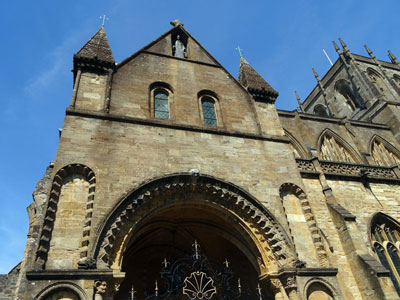
I can spot Romanesque when I see it – interlaced arcading over the south west porch

Anglo-Saxon carvings beside the south west porch
But the great rebuilding of the abbey was in perpendicular style between 1380 and 1500.

Most of Sherborne Abbey is in Perpendicular style
The monks and the people of Sherborne did not always get on very well. The monks built a small Church of All Hallows joined to the west end of the abbey, for use by the townspeople, who resented being pushed out of “their” church.
The abbots spent a lot of the town’s wealth on the abbey, were landlords of much of the town and monopolised the water supply. But by the 15th century the townspeople were more independent and raised enough money for their own almshouse, which they built right opposite the abbey in 1437.

The almshouse in Sherborne, built by the townspeople in 1437
In the same year, sick of going cap in hand to the abbot to use the abbey font for baptisms, the people decided to build a font of their own in All Hallows. According to contemporary sources the abbot was so angry that he sent a “stout butcher” with a hammer to smash the new font.
A riot followed and a burning arrow caused a fire in the east end of the abbey, where wooden scaffolding was being used for roof rebuilding. The fire reddened the walls of the quire and the crossing in the middle of the church, beneath the tower. The Pope himself settled the conflict but the townspeople had to pay for the repairs.

If I am not mistaken, the stone on the far right of this picture is reddened by the riot and fire of 1437

The fan-vaulting was completed around 1490 and is apparently the oldest in England

The vaulting is an amazing achievement, isn’t it?

A long view of the inside of the abbey, looking east

I love these little details and wonder whose shield this is…
After all the arguments it’s no wonder the townspeople were delighted to get their church back when the Benedictine foundation ended with the Dissolution of the Monasteries by King Henry VIII in 1539. Sir John Horsey bought the abbey from the king and sold it back to the townspeople for £320 (tens of millions these days) to be their parish church. The small All Hallows Church was demolished.
The king’s commissioners had stripped the inside of the church bare and later the stained glass was removed and the walls whitewashed. The few undemolished abbey buildings behind the church became part of a school that had existed here since 705, now Sherborne School. In 1560 the east end of the main church building was made into a house for the headmaster of the grammar school. You can still see the sundial, Tudor coat of arms and, underneath, arms of the school’s benefactors.

The east end of the abbey

The sundial was telling the right time according to GMT, although we were on British Summer Time when we visited

The Tudor coat of arms
I get the impression that the place was just ticking over until Victorian times, when there was another big investment in the building. The main restoration was between 1856 and 1858 and this included the great east window, which shows the suffering of Christ.

The great east window has Victorian glass by Clayton & Bell
Below it the reredos, designed by RH Carpenter, is made of pale Caen stone – it shows the Ascension

The reredos

I think this small window with faceless people is one of the few remaining fragments of medieval stained glass at the abbey

In 1998 the beautiful west window by John Hayward replaced a Victorian window by AWN Pugin, made by Hardman, which had faded badly because of under-firing

The Virgin and Child at the centre of the west window
The abbey’s organ was installed in 1856 by Gray & Davison but completely rebuilt in 1955 by JW Walker & Sons, though it had to be restored again in 1987. This was musically and mechanically unsuccessful and the organ became unreliable so it had to be rebuilt again, very thoroughly, by Kenneth Tickell in 2003/2004. Another nave organ was added under the west window.

The church organ is in the north transept

A closer look

The beautiful decoration on the organ pipes reminds me of foil wrapping paper
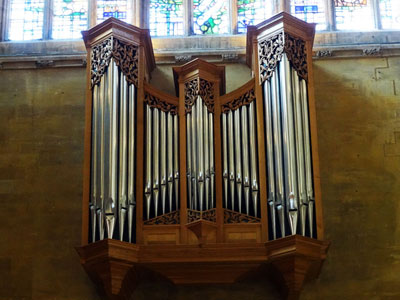
The nave organ under the west window
In front of the abbey is a lovely memorial to the man who paid for a lot of the Victorian restoration – George Digby Wingfield Digby, who provided a lot of funding for renovation work during the 19th century. It was built in 1884 and features statues of St Aldhelm, Bishop Roger of Salisbury (Roger de Caen), Abbot Bradford and Sir Walter Raleigh. This was a Digby of Sherborne Castle and must surely be related to the Digbys of Minterne House.

The Digby Memorial is on the far right of this view of the abbey

The front of the Digby memorial, with St Aldhelm and Sir Walter Raleigh

Sir Walter Raleigh and Abbot Bradford
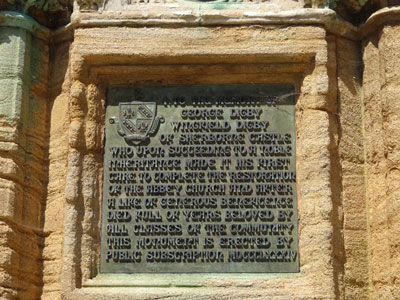
The plaque reads ‘To the memory of George Digby Wingfield Digby of Sherborne Castle who upon succeeding to a noble inheritance made it his first care to complete the restoration of the abbey church and after a life of generous beneficence died full of years beloved of all classes of the community this monument is erected by public subscription MDCCCLXXXIV’

Bishop Roger and St Aldhelm

Sir Walter Raleigh – after an eventful life elsewhere he retired to the estate in Sherborne given to him by Queen Elizabeth and was at one time a Member of Parliament for Dorset, although at other times he was an MP for Cornwall and for Devon


Pat, you bring back so many memories with your posts of Dorset! Sherborne is another place OH and I used to go before the boys were born. It was on our radar in the summer when we went to Porlock (passed by) but as with most things, became forgotten (already! I know …).
Fascinating article. Thank you.
Glad it rang a bell with you. It’s a lovely little place, so clean! I will probably post again one day soon with a few images of the town itself.
All the best 🙂
Good to hear that the swifts are observed and welcomed by the church goers and abbey authorities. Swifts are in trouble for many reason, not least from house repairs leaving no cracks for them to nest behind. Unlike some nesting birds, they create very little mess and we need to encourage them. There is a fantastic new low cost ‘swift brick’ – a self- contained swift home that can easily be incorporated in new build or house repairs. See http://www.manthorpe.co.uk/Building/Products/Conservation/Swift-Nest-Brick.html.
Her in Cardiff, we are working with the Council to ask house-builders to incorporate such measures with some success. More on swifts at http://www.swift-conservation.org/
Thanks so much for the information – those links are fascinating, especially the “swift brick”! What a great idea.
I must admit I haven’t heard as many swifts this year.
I remember when I was a child my brother picked up a swift that had fallen to the ground and couldn’t get up because of its long wings and short legs, so he just held it up and it was on its way again.
We went for coffee at Chapter today and thought of you and your family when we saw the Stiwdio Seligman…
Best wishes 🙂
When I last visited the Abbey I remember a number of military flags hanging in one part. For some reason they had a big effect on me.
I think I know what you mean from a picture in the guide book, although for some reason I didn’t get to this area of the church, maybe it was temporarily closed off?
It’s the Lady Chapel. The caption to the picture says: The abbey has a special relationship with the Dorsetshire Regiment. All 38 of its known colours, each with a framed history, are displayed near the Lady Chapel or in the North Aisle…
In the image you can see all the union flags hanging, in various states of repair, as I suppose they were actually taken into battle in the past.
All the best 🙂
Yes, it felt, rightly or wrongly, like these flags were a witness of the battles the Dorsets had been involved in.
War seemed more heroic in those days, but I don’t suppose it was…